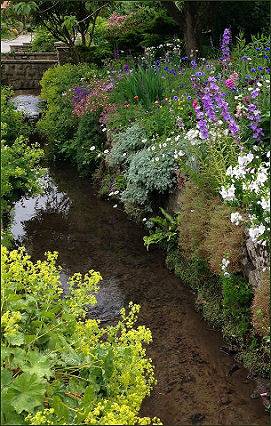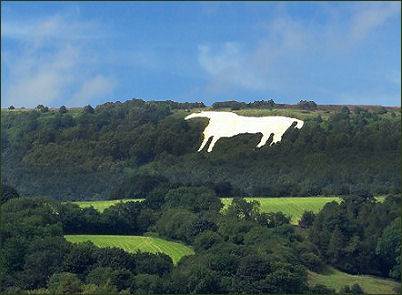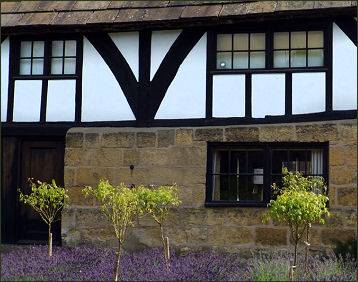Kilburn
OS grid reference:- SE 512 797
 Kilburn is a picturesque village which lies on the edge of the North York Moors National Park, around 6 miles north of Easingwold.
Kilburn is a picturesque village which lies on the edge of the North York Moors National Park, around 6 miles north of Easingwold.
The village's name derives from two Anglo-Saxon words, ciele & burna, meaning "cool stream". A settlement of ancient origins, Kilburn is mentioned in the Domesday Book of 1086, were it is referred to as "Chileburne". . At the time of the Norman conquest, the lord of the manor was one Arnketil, but it was later granted to Hugh, son of Baldric by Willliam the Conqueror.
In the reign of King Henry I the manor was passed to Rouen Cathedral in Normandy and subsequently to Roger de Mowbray, before ending with the Archbishopric of York after the dissolution of the monasteries in the sixteenth century.
 Robert de Alneto, a monk from Whitby Abbey lived in a hermitage at Hood Grange, around 2 miles from the village. In 1138 Robert de Mowbray converted the building into a Cistercian abbey, which later became Byland Abbey. The Norman village church, a Grade II listed building, is dedicated to St Mary and dates to the early twelfth century.
Robert de Alneto, a monk from Whitby Abbey lived in a hermitage at Hood Grange, around 2 miles from the village. In 1138 Robert de Mowbray converted the building into a Cistercian abbey, which later became Byland Abbey. The Norman village church, a Grade II listed building, is dedicated to St Mary and dates to the early twelfth century.
The village is known for the White Horse, a figure cut into the hillside above the village, which is visible from some miles away. It measures 318 feet (97 metres) long by 220 feet (67 m) high and covers about 1.6 acres (6,475.0 m2). The Kilburn White Horse is thought to be the largest and most northerly hill figure in England. It was created by removing the topsoil, exposing the underlying rock and covering it with white limestone chips. It was created in November 1857, some accounts state that it was done by school master John Hodgson and his pupils. Thomas Taylor is also the credit for being the prime mover in the creation of the horse, a native of Kilburn, he was a buyer for a London provision merchant and seems to have attended celebrations at Uffington White Horse in 1857
A signposted Forestry Commission car park is available a mile to the north of the village, from where steep steps climb up the side and around the top of the horse figure, which provides superb views over the Vale of York and on a clear day, the Yorkshire Dales.
The Mouseman Visitor Centre
The famous furniture maker Robert Thompson (7 May 1876 - 8 December 1955), better known as the 'Mouseman of Kilburn' lived in Kilburn.
 Thompson set up a business in the village manufacturing oak furniture, which featured a carved mouse on almost every piece. He taught himself to use traditional tools and by 1919 he was experimenting with his own ideas for producing furniture based on the English styles of the seventeenth century. He was part of the 1920s revival of craftsmanship, inspired by the Arts and Crafts movement led by William Morris, John Ruskin and Thomas Carlyle.
Thompson set up a business in the village manufacturing oak furniture, which featured a carved mouse on almost every piece. He taught himself to use traditional tools and by 1919 he was experimenting with his own ideas for producing furniture based on the English styles of the seventeenth century. He was part of the 1920s revival of craftsmanship, inspired by the Arts and Crafts movement led by William Morris, John Ruskin and Thomas Carlyle.
It is claimed that the mouse motif came about accidentally in 1919 following a conversation about "being as poor as a church mouse", which took place between Thompson and one of his colleagues during the carving of a cornice for a screen. This chance remark led to him carving a mouse and this remained part of his work from this point onwards.
His workshop, which is now being run by his descendants, includes a showroom and visitors' centre, and is located in the restored Blacksmith's and Joiner's shops with the adjacent cottage, beside St. Mary's Church, which contains "Mouseman" pews, fittings and other furniture.
The company is now known as "Robert Thompson's Craftsmen Ltd - The Mouseman of Kilburn." The centre first opened to the general public in April 1994. The displays were housed in Robert Thompson's original workshop and the adjoining Blacksmiths shop.
Set in landscaped gardens the buildings include the Mouseman Museum, a Cafe and a Gift Shop. The Centre is open for visitors from Easter to Christmas with reduced hours from October onwards.
